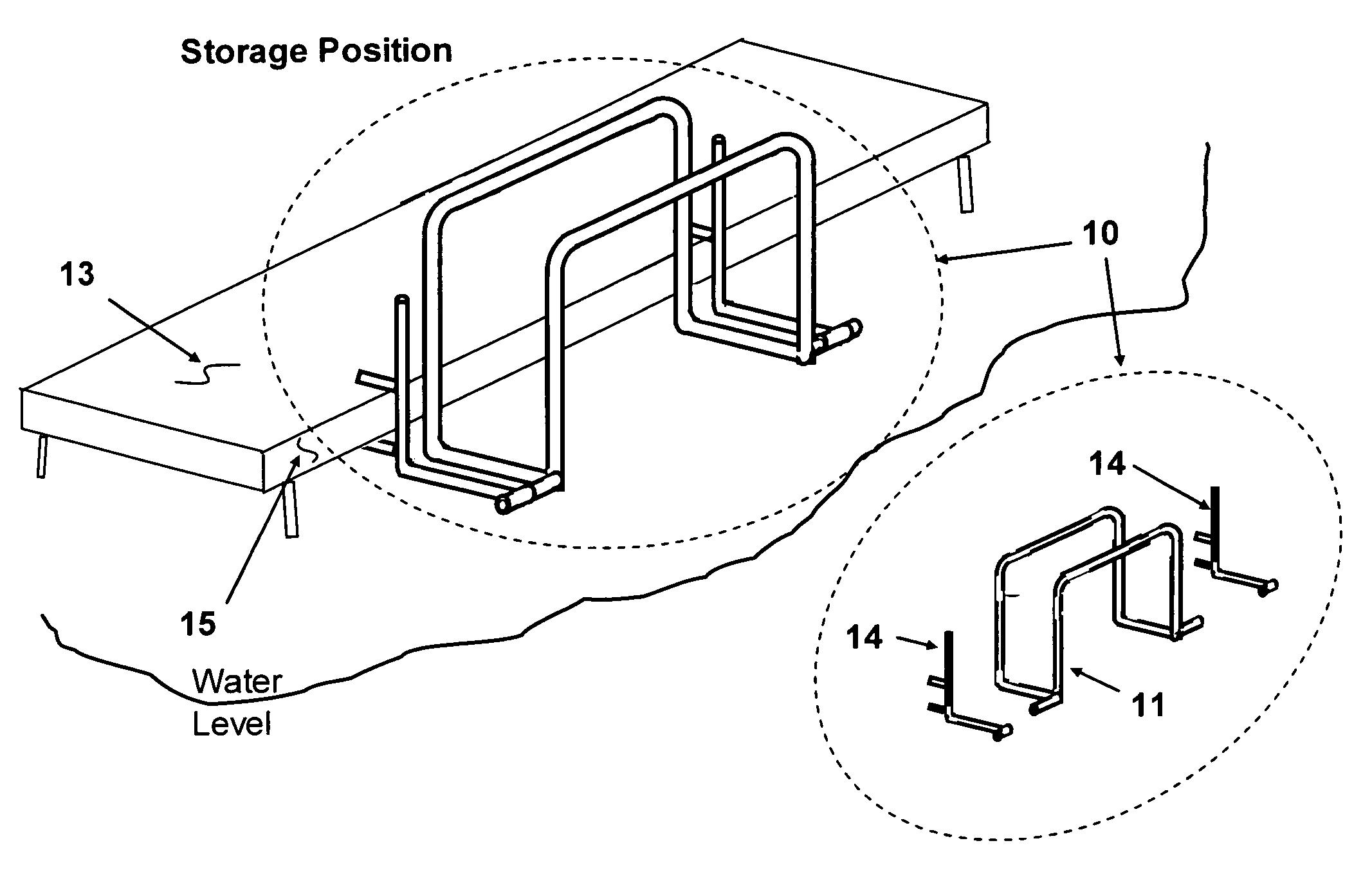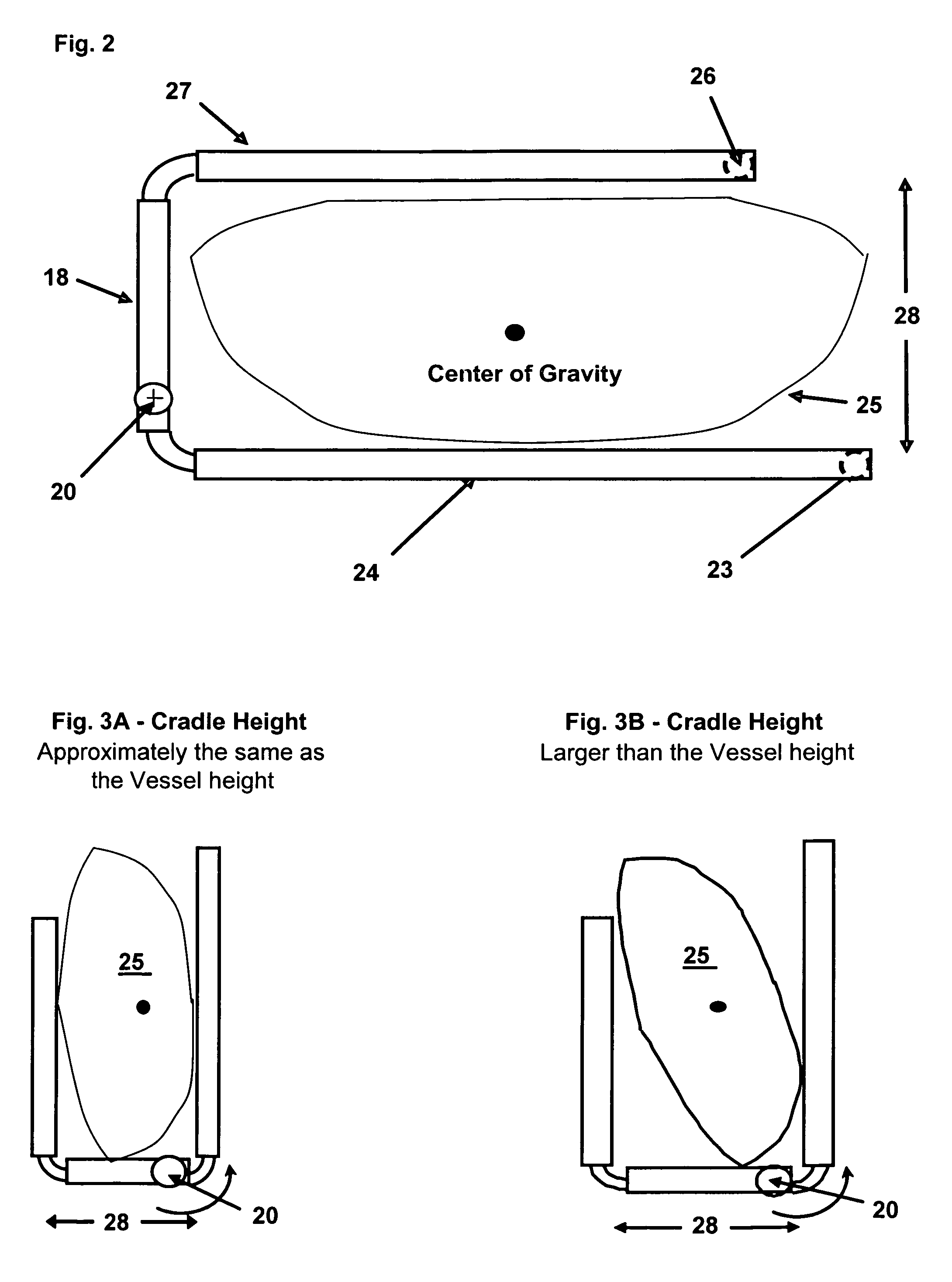Since these vessels usually weigh between 35 and 85 pounds and range in length from 9 to 17 feet, they are quite difficult to lift and cumbersome to transport, even over short distances, especially for one person.
But when small vessels are stored on the dock surface, most of the dock width is obstructed, blocking access to the far end of the dock.
Moreover, as there is typically a variance of 8 inches to 36 inches or more of
freeboard between the dock surface and the water, lifting the boat onto the dock surface is clumsy at best if not impossible for one person and may result in damage to the boat and / or the dock and / or potential personal injury.
Since the lifting force is provided by a
winch mechanism on the dock side of the cradle, lifting from the water side is not enabled, and therefore one person cannot easily put the vessel into the cradle and then lift it without moving from the water side to the dock side.
This necessitates a time-consuming two-stage process.
The
winch assembly and the lifted cradle also occupy considerable dock space and present an obstruction.
It could also be adapted for use with a floating dock, but it would not be suitable for a fixed dock having a variable
freeboard.
Like the Horton patent, it achieves vertical storage on the surface of the dock, thereby creating an obstruction.
Anderson also shares the
disadvantage of Horton of requiring a two-stage attachment-lifting process, since it provides no
mechanical advantage for lifting from the water side.
Since the vessel is clamped at the
gunwale to the lifting arm, moreover, this mechanism is useless for kayaks and can damage canoes and rowboats by the “pinching” stress placed on the
gunwale.
But the flexible loop cannot secure the vessel in a vertical position for storage over the water on the side of the dock.
As with Horton and Anderson, the
winch lifting mode requires a two-stage attachment-lifting process, and the derrick structure occupies a lot of space on the dock surface.
The extent to which the mechanism can operate with a high freeboard is limited by the length of the horizontal boom and the span of the lifting cradle.
This device also lacks a side support under the vessel once it's lifted, so that the sag of the flexible member will render the storage height above the water uncertain and unstable.
Lunsman also shares the disadvantages of the other winch-actuated devices in terms of a two-stage operation and obstruction of dock space.
But, because the davit's pivot point is fixed at dock level, downward extension of the davit has two adverse consequences.
Since the length of the lever arm is fixed, lifting the boat will become quite difficult in high freeboard conditions.
Lowering the davit also causes the storage position of the boat to extend further out over the water from the dock edge, which creates an obstruction for other vessels using the dock, as well as multiplying the stress on the davit
assembly under windy conditions.
Like the other prior art, Lasko does not enable single-stage cradling and lifting (i.e., in which the operator stays on one side of the vessel?) of the boat.
The rotation of the lever arm downward to the dock requires the user to bend over pushing downward to the dock (which can cause
back injury) where a latch mechanism engages and holds the cradle in horizontal position.
As with the Anderson patent, this apparatus is useless on a fixed dock that's subject to seasonal freeboard variations.
Even as applied to a floating dock, this device becomes very inefficient for freeboard heights of less than a foot, because the reduced length of the lever arm will demand excessive torque to turn the winch.
Although the Palmer mechanism provides a more
stable storage position with less dock obstruction than the other prior art, it uses hooks to attach the davit to the gunwales of the boat, thereby subjecting the sides of the vessel to potentially damaging pinching and shearing stresses.
Since, like the other prior art, the Palmer device does not enable water-side boat lifting, it requires a burdensome two-stage operation.
1. Obstruction of dock space by the lifting apparatus;
2. Obstruction of dock space by storage of the boat over the dock surface;
3. Two-stage operation: first water-side boat attachment, then dock-side lifting;
4. No means available to operate from the waterside only;
5. No means available to operate from the waterside or dockside at the user's option;
6. Inability to accommodate variable dock freeboard;
7. Excessive lifting force / torque;
8. Lack of stability in the vertical storage position;
9. Potentially damaging
shear stress on boat and / or dock sides during lifting;
 Login to View More
Login to View More  Login to View More
Login to View More 


